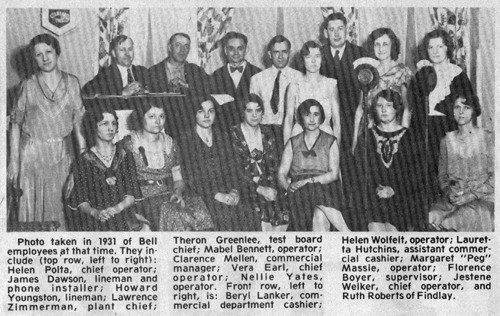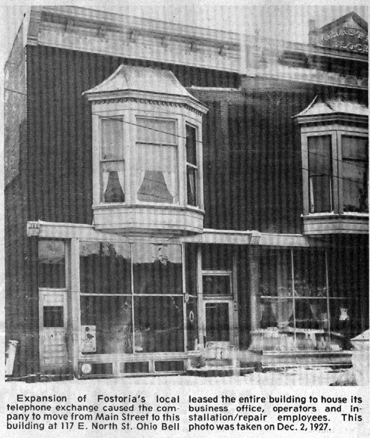February 24, 1983


Picture #1 – Photo taken in 1931 of Bell employees at that time. They include (top row, left to right): Helen Polta, chief operator; James Dawson, lineman and phone installer; Howard Youngston, lineman; Lawrence Zimmerman, plant chief; Theron Greeniee, test board chief; Mabel Bennett, operator; Clarence Mellen, commercial manager; Vara Earl, chief operator; Nellie Yates, operator; Front Row, left to right: Beryl Lanker, commercial department cashier; Helen Wolfelt, operator; Lauretta Hutchins, assistant commercial cashier; Margaret “Peg” Massie, operator; Florence Boyer, supervisor; Jestene Welker, chief operator, and Ruth Roberts of Findlay.
Picture #2 – Expansion of Fostoria’s local telephone exchange caused the company to move from Main Street to this building at 117 E. North Street. Ohio Bell leased the entire building to house its business office, operators and installation/repair employees. This photo was taken on Dec. 2, 1927.
Author’s Note: Last week’s article about the early years of telephone service in Fostoria and the phone models covered history that only the “oldsters” probably knew. Today’s article, the second in the series covers the middle years to the present.
Many readers will recall when the Ohio Bell office and exchange were in the building on East North Street, shown in the accompanying photo. Customers paid their bills and operators and installation and repair employees were headquartered there. The number please women were on the second floor where the callers were connected with their parties via hand-operated switchboards.
In later years, Ohio Bell built a new building just east of 117 E. North St. and installed all of the equipment for the new local dial system which went into effect in 1940. The new building also housed the business offices for the company.
There are still a few of the number please women living in the area who worked for Ohio Bell.
DIAL PHONES IN 1940
It was in 1940 that the manual telephone switchboards became obsolete and all calls were dialed by the caller. The only need for operators was for certain long distance phone calls and other operator-assisted calls. For those types of calls, the reduced staff of operators was located in the Findlay Bell office. Bell tried to transfer operators to other cities whenever possible. Telephones and services have changed tremendously through the years, but the friendships and memories of the past remain the same.
While gathering data for this article, I spent an evening with the Welker sisters – Bonnie and Mille – in their home along with Vera (Earl) Stoneberger and Mabel Smith – all veteran employees of Ohio Bell. Other employees names and events of past years flew thick and fast during the evening.
More recently, at Mabel Smith’s home on Leonard Street, she and I went through two scrapbooks she has kept since she joined Ohio Bell in 1929 and after her termination in 1940 when Fostoria went “dial”. She had kept scrapbooks from whenever the “old gang” gets together. Alumni had their first reunion in 1941 and the most recent in 1982.
Quite often at the reunions, a telephone call would come through from Mrs. Fred (Marie) Yaryan, one of the operators who now lives in Los Gatos, CA.
REMEMBER THESE NAMES AND FACES
The accompanying photo, representative of the group from earlier years will help recall faces for readers as well as for Ohio Bell folks.
The following list of Ohio Bell female employees, taken from published news items of reunions, is the only one available. Hopefully, there are no omissions.
Gertrude Hollenbaugh Boyd, Celia M. Youngston, Florence Jacobs Drey, Bertha Kay Foote Kauffman, Beryl Lanker Miller, Lela Kinney McAnaney (chief operator), Mabel Bennett Smith, Bea Mosier Grashel, Tillie Bishop, Vera Earl Stoneberger, Helen Polta (chief operator), Mary McElfish, Margaret “Peg” Massie, Leona Dible.
Marguerite Schaar, Ruth King Huth, Lula Hoffer, Rita Merchiruo, Lauretta Beatty, Ethel Lawrence Mall, Alta Preble, Jerry Ohl, Marie Yochum, Nellie Clyde Fisher, Erma Reeve, Mabel Went Manecke, Helen Wolfelt Turner, Wanda Thompson McDonald, Gladys Richard Fleming.
Margaret Jones, Dorothy Flechtner (chief operator), Dorothea Shondell Coil, Wanda Molnor, Lena Weber, Beaulah Kauffman Anderson, Nellie Yates Leeson, Irene Lawrence Apple, Marie Yaryan, Jestine Welker, Bonnie Welker (chief operator), Ruth Haddox, Grace Duffey Boos, Marie Sauber, Pearl Ropp.
Maude Frysinger (chief operator), Emma Doty (chief operator), Virginia Krupp Fox, Florence Boyer, Lauretta Hutchins Smith, Edna Frankenfield, Sylvia Senn, Rose Wilhelm, Mrs. Harold Anderson, Mrs. Roy Myers, Mrs. L.B. Stearns, Mrs. S.J. Lawless, Mrs. Harold Stumpp, Helen Romig, Nina Nobbs Keiser, Thelma Collins (chief operator).
Vara (Earl) Stoneberger served as operator and also as clerk under six chief operators: Wolfelt, McAnaney, Collins, Polta, Flechtner and Welker.
The old-timer local male employees of Ohio Bell are: Jim Dawson, Howard Youngston, Jack Myers, Theron Greenlee, Al Bryner, Maxwell Snyder, Robert Delp, Robert Lance, Harry Smith. They were all involved in repair, installation and technical work.
FOUR “PIONEERS” IN FOSTORIA
Many years ago, Bell instituted the Pioneers Club, consisting of employees who worked for the company more than 20 years. According to Ohio Bell, Robert Baxter, Milton Dunn Jr. and Kenneth Woessner are still local employees and members of the club, as is Bonnie Welker. She worked at the Bell Findlay office after operators were no longer needed here, and then later moved to California and worked for the telephone company there, returning to Fostoria after her retirement.
Others still employed by Ohio Bell local in addition to Dunn, Baxter and Woessner are: Dan Wolph, don coburn, Rick Osterwalder, Shelby Roberts, Jim Brandt, Denny McCoy, Duane Reynolds, Jim Shriver, Gene Preston, Jim Beeson, Ron Anderson, Chuck Wall, Sue Sponsceller, the latter being stationed at the Phone Center on East Tiffin Street. All the others are involed in repair, installtion, cable work and as technicians.
SOPHISTICATION ON ITS WAY
Gathering the above names, I visited the Bell Central Office on East North Street and was treated to a tour of the facilities by Jim Brandt. He showed me the intricate facilities that displaced the hand-operated equipment and operators in 1940. Fostoria was one of the first to get the new dial system.
I learned that sometime in the next several years, all of that equipment now used there will be obsolete. It will be replaced with still more modern circuitry, more foolproof and so much more compact that it will occupy about one fourth as many employees to maintain.
I knew that the electric current to operate the telephone system was direct current, supplied by batteries, but never visualized what they looked like, how large they were. I had no idea of the backup equipment necessary in case of emergency.
If disaster strikes the direct current system, a standby fuel-operated generator is ready to provide direct current immediately to keep the phone system working. Another system operated continually in the central office to inject air into all cables that hold the telephone wires to keep them dry.
In 1982, Ohio Bell spent $1.5 million and in 1983, it projects it will spend $1.6 million on cable maintenance, repair and installation in the Fostoria area, according to Don Fruchey. Bell representative.
PEOPLE AND HOUSES ON CROCKER STREET
Esther Shaffer continues reminisching about the north side of Crocker Street, starting at Poplar.
NO. 236 – Sylvester Schubert, bachelor brother of the next neighbors, Mrs. Herbert and a retired farmer, lived there until his death. At that time, it was a rental property. A family named Baeder lived there as did the Albert Flechtners and their daughter Margaret. During World War II, the Holden family was the owners. It was then purchased by Mr. and Mrs. Odell Dunn.
NO. 238 – The George Gerlingers were the owners of the property, their children being Dorothea, Freda and Martha. Dorothea created quite a stir in Fostoria when she was chosen the most beautiful girl in Ohio and was awarded $5,000. The judges were artists and movie scouts. She was called a perfect Italian Renaissance type. Freda married Fred Dillery and they have been active in Masonic and Eastern Start work. Martha chose a business career in Dayton and was very successful.
The Fred Herberts, retired farmers, were next purchasers. Mr. Herbert had tuberculosis of the bone, was on crutches and died soon after they moved there, about 1915. Their daughter Ina, and her husband D.L. Fruth, then moved in and rented their house at 251. The Herberts sold the house some 50 years later to Mr. and Mrs. Ralph Hammer, who acquired a family during the time they were on the street.
NO. 240 – It was known as the Hazen House. John Hazen was killed in the fireworks factory explosion in 1904. He didn’t work there, but had been called in because of his knowledge of machinery. Mrs. Hazen the former Nettie Cramer, was a fine musician as were her sons, John Clair and Charles. She played the piano. Charles the cornet and Clair plated several instruments. The sons and their mother were on the Chautauquz Circuit for several summers. Both men saw service in France in World War I.
When Jack Wainwright started his Fostoria band, he also started one in Bucyrus and Clair was placed in charge. Hazen soon took over on his own and was director of instrumental music in Bucyrus schools until his death from a heart attack at the age of 40. Charles worked in the office of the Allen Motor Co. and moved to Columbus with them. He played for a number of good bands during the big band era, but he too died young from tuberculosis of the throat and from injuries received in his war service. Mrs. Hazen was active in musical affairs, the Methodist Church and veterans, including the Relief Corps. and legion auxiliary.
The house was later sold to the Rommig family then later to Ralph Hammer.